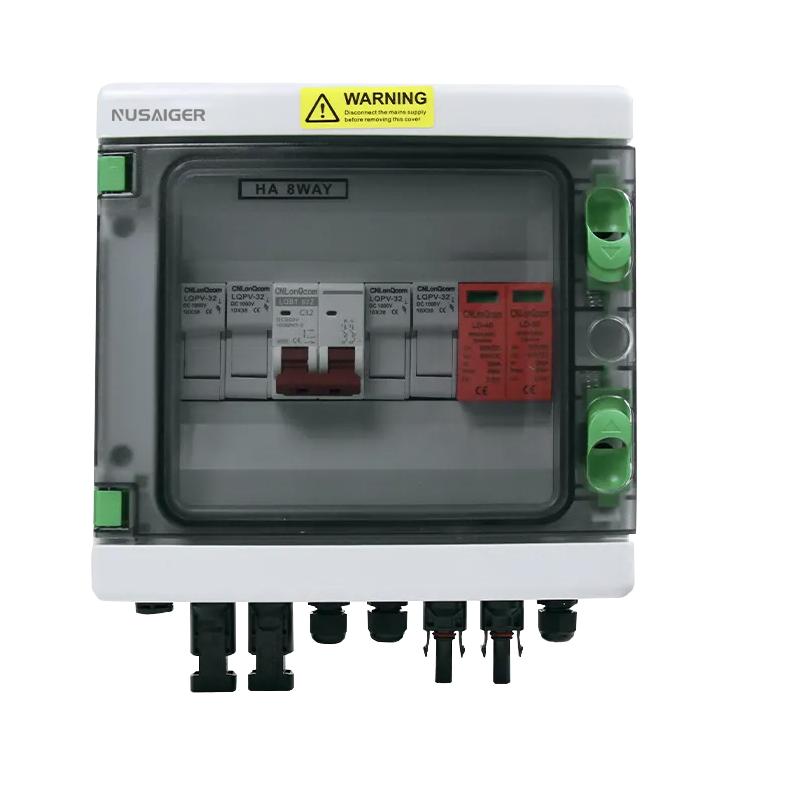How to Select the Right PV Combiner Box for Residential and Commercial Solar Projects
Choosing the right PV combiner box is a pivotal decision when planning a reliable, efficient, and safe solar power system. Whether for a residential rooftop, a commercial building, or a utility-scale solar farm, the combiner box must match the system’s size, voltage rating, environment, and safety requirements. In this guide, we walk you through the detailed process of selecting a PV combiner box tailored to your project needs.
1. Understanding the Role of the PV Combiner Box
The PV combiner box functions as a centralized junction point in the solar DC circuit. It consolidates multiple strings of photovoltaic panels into one or more outputs leading to the inverter. Additionally, it integrates vital safety components such as fuses, surge protectors, and disconnect switches.
1.1 Key Benefits:
- Consolidation of multiple DC inputs
- System protection from faults and surges
- Simplified wiring and maintenance
- Performance monitoring integration
2. Factors to Consider When Choosing a PV Combiner Box
2.1 System Size and String Count
Determine the number of solar panel strings you need to combine. For a small home system, this might be 2–4 strings, while commercial projects can range from 8–48 strings.
2.2 Voltage Compatibility
Most residential systems run at 600V DC or lower, while commercial/utility systems commonly use 1000V or 1500V DC. Choose a box rated for the appropriate system voltage.
2.3 Current Capacity
Verify that the combiner box can handle the maximum expected string current and total output current. Look for busbars, terminals, and cables with sufficient ampacity.
2.4 Environmental Conditions (IP Rating)
Installations in outdoor environments require a minimum IP65 rating for dust and water resistance. In corrosive or humid areas, stainless steel or UV-resistant plastic enclosures are recommended.
2.5 Safety Features
- Fuses or DC circuit breakers for each string
- DC disconnect switch
- Surge protection (SPD Type 2 or Type 1+2)
2.6 Monitoring Capability
For advanced applications, consider smart combiner boxes with:
- String-level current monitoring
- Communication ports (RS485, Ethernet, Modbus)
- Temperature sensors
- Remote data access via SCADA or cloud
2.7 Compliance with Standards
Ensure compliance with:
- UL 1741 (U.S.)
- NEC 690
- IEC 61439 (International)
- RoHS and CE (Europe)
3. Residential PV Combiner Box Selection
Residential systems are often small-scale (2–5 kW) and located in non-industrial environments. Here are specific recommendations:
- Strings: 2–4 input strings
- Voltage: 600V DC
- IP Rating: IP65 or higher
- Monitoring: Optional, based on budget
- Material: Polycarbonate or powder-coated aluminum
3.1 Example Use Case
A 4.8 kW rooftop system with 3 strings of 8 panels each may use a 3-string PV combiner box rated for 600V DC, 15A per string, and featuring Type 2 SPD and an integrated disconnect switch.
4. Commercial and Industrial PV Combiner Boxes
In commercial installations (e.g., factories, warehouses, commercial rooftops), more power and strings are involved, and monitoring becomes important.
- Strings: 8–24 input strings
- Voltage: 1000V or 1500V DC
- Monitoring: Strongly recommended
- Material: Stainless steel or fiberglass-reinforced enclosures
4.1 Example Use Case
A 100 kW rooftop system using 16 strings of 20 panels each (330W panels) would require a combiner box with 16 fused inputs, rated for 1000V DC, 20A per string, and include string-level monitoring and RS485 output.
5. Utility-Scale Solar PV Combiner Boxes
These are custom-designed boxes built to handle high voltages, multiple strings, and demanding environments.
- Strings: 24–48 or more
- Voltage: 1500V DC
- Monitoring: Essential with redundancy
- Certifications: Full NEC, IEC, UL compliance
- Add-ons: Redundant SPD, smart breaker trip indicators, fiber optics
6. Material Selection and Durability
The choice of enclosure material can significantly impact the combiner box’s lifespan:
- Stainless Steel: Excellent corrosion resistance, ideal for coastal or industrial zones.
- Polycarbonate: Lightweight, UV resistant, cost-effective for residential use.
- Aluminum: Good strength-to-weight ratio, needs surface treatment.
7. Cable Management and Internal Layout
An organized internal layout ensures safe operation and easy maintenance:
- Proper spacing between components
- Labeling of fuses and terminals
- Flexible cable entry glands
- Accessible terminals for voltage testing
8. Brand and Vendor Considerations
While selecting a PV combiner box, prioritize brands with:
- Certifications and test reports
- Global project experience
- Warranty and service availability
- Customization capability
9. Cost vs. Performance Tradeoffs
While basic combiner boxes may be cheaper upfront, long-term reliability and maintenance costs must be considered. Smart combiner boxes with built-in diagnostics can reduce downtime and improve ROI.
10. Final Selection Checklist
- ✅ Match system voltage and current
- ✅ Check environmental protection rating
- ✅ Ensure sufficient string input capacity
- ✅ Verify certifications and compliance
- ✅ Choose appropriate safety and monitoring features
Conclusion
Selecting the right PV combiner box is not just about fitting the wires—it’s about enhancing system reliability, maximizing performance, and ensuring long-term safety. A well-chosen combiner box can reduce installation costs, improve maintenance workflows, and protect your solar investment.
Whether you’re powering a home or running a multi-megawatt solar farm, make the combiner box selection a deliberate and strategic process. Consult with certified solar electricians or system integrators to tailor the box configuration to your unique requirements.



